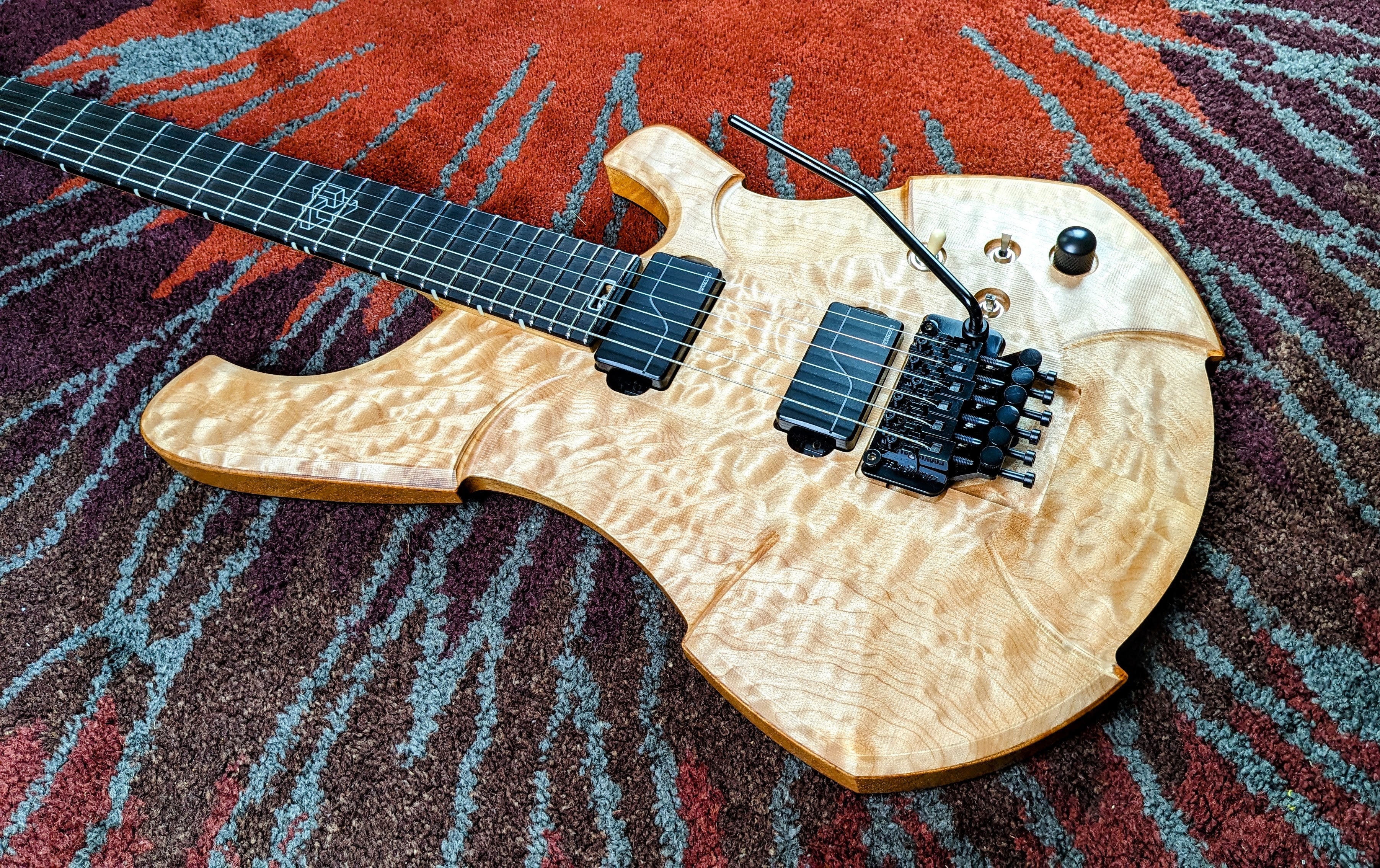TEN32 Features
I don't have much touring experience as a musician, but I did play a ton of local shows here in Denver back in the day. Certainly enough for anything and everything to go wrong at least once. I used those experiences (or at least the ones I remember) as inspiration for improving as many aspects of the instrument as possible.
1. Optional Bolt-on Headstock (Patent Pending)


2. The TEN32 Case (Patent Pending)

Would you buy a socket set if all the parts were just floating around in the bottom of a plastic bag? I sure wouldn't. Sometimes part of a product's usefulness lies in how well it's stored and transported. I'd say this is true for my guitars. A modular, portable guitar loses a lot of its value if you cant safely transport it, and if that guitar is designed to be easily reconfigurable you'll need a place to store the parts you may want to swap out, and all the tools necessary to make those changes.
Wouldn't it be nice if all of this stuff was all in one package? It is now. You've got tools for literally everything that requires them, including wire snips and a winder for string changes. All the storage cavities are undercut, meaning the parts and tools stored within are mechanically prevented from falling out, so they can't damage the body during transport. The case fits under an airplane seat, but will cost you some leg room. At just over 4" thick, you can almost always find a slot for it in the overhead bin.
A complete blog post on the case is available here.
3. Modular Necks & Headstocks (Patent Pending)
Ever wanted to change the look of your headstock, or change from a 24.75" LP scale length neck to a 25.5" Strat scale length all with the same body, bridge, pickups, etc?
Probably not, considering its never really been possible before.
I get mixed reactions on this one, I think because it's such a foreign concept, but if you like the idea, its 100% doable. Every TEN32 neck is engraved with its scale length like so:

4. Neck Indexing System
Since you're already wondering "wtf are those black parts?" in the image above, lets cover the neck indexing system. Basically, if the neck lands in even a slightly different position on each assembly, intonation will be negatively affected. This problem can't be addressed with a tighter neck pocket because wood expands and contracts depending on environmental factors, so you have to leave enough room to account for these fluctuations. Of course this also means the neck can wiggle a bit in the pocket before it's bolted in place. The indexing system solves this problem, ensuring accurate intonation on every assembly.
The mating surfaces you're seeing consist of epoxy with 20% milled carbon fiber mixed in, cured under pressure at 55 PSI in a temperature controlled vessel. Considering its also supported by the sides of the pocket, and the fact that it all gets locked together when the neck is bolted on, it should last for the life of the instrument.
5. Integrated Tool Storage

I can't stand it when I need a particular tool and for whatever reason just don't happen to have it, so I wanted redundancy in this department. The case stores everything you'll need to work on my guitars, and usually in duplicate. There are actually 3 different 3mm wrenches stored in the case, since its the tool you'll use most (more on that here), but what if the case doesn't happen to be nearby? You're still covered.
All TEN32s include magnetic storage for Allen wrenches right in the back of the body. A long ball nose 3mm Allen key, wrenches for adjusting pickup height, removing/installing blade switches, saddle intonation, saddle height, and swapping modular nuts are all stored right in the back of the body, along with a truss rod adjustment tool. If you lose one, A) there's a backup in the case and B) they're standard wrenches available everywhere for easy replacement. I can also store your trem bar magnetically in the back of the body.
6. No Destructive Fasteners
This one's simple...if you want to disassemble and reassemble a guitar an indefinite number of times you just plain cant use destructive fasteners (wood screws). This is why every function of my guitars that requires a fastener uses stainless steel fasteners on stainless steel threads, or in some cases aluminum threads to keep weight and corrosion risk to a minimum. All of my embedded SS threaded receptacles are both flanged and hexagonally locked in place. They cannot be spun out, they cannot be pulled out.
7. Modular Nuts (Patent Pending)

Locking nuts are typically fastened either with a risky thru-neck configuration or with wood screws. The former leaves you with a weakened neck/headstock joint that's prone to breaking. The latter is a destructive fastener so can only be removed and reinstalled a few times. Neither allows for the use of a different nut. You're pretty much stuck with the nut type the neck was designed for, for the life of the neck. Non-locking nuts are typically glued down. Yuck.
TEN32 nuts are modular, use non-destructive fasteners, and allow for the installation of 3 different nut types - locking, standard, and zero fret (coming soon). Just remove 2 screws to change between types. This is one of 2 instances where a TORX drive is necessary to make sure the screw head doesn't strip out, but your TEN32 will ship with that wrench both in the case and magnetically stored in the body. TEN32 nuts are custom machined to match your EXACT string gauges, and those gauges are engraved right onto the nut.
8. Jack Clamp (Patent Pending)

No, its not a new Tom Cruise character. If you've ever tried to replace an output jack, you already get it. The main issue is just a lack of space to operate in. Combine that with a soldering iron and a bunch of wonky leads and this seemingly simple operation can turn into a frustrating experience.
So what's the fix? Simple. Get the jack out of the body so you have more space to work with and fewer obstructions in the way. Enter the TEN32 Jack Clamp. Simply remove two machine screws to release the clamp, and you're free and clear to do whatever you need. If you're wondering - that's a wireless transmitter stored right in the back of the guitar, another TEN32 exclusive option.
9. Brass String Block (Hipshot hardtail models, patent pending)

One of the bridges I offer is a custom version the classic Hipshot hardtail. Its a string-thru design so the ball ends of the string terminate on the backside of the instrument. The idea is to solidly couple the bridge with the body by sandwiching it between the bridge itself and a fat block of brass on the backside, then running 5 machine screws between the two, tightened down as hard as you like.
The block of brass on the backside also captures the string balls. In theory, by coupling the bridge with the body we get a better acoustic response. I upgrade all Hipshot bridges with carbon steel intonation and saddle height screws. They'll hold up much longer than the factory fasteners.
10. Solderless Electronics
I cant take credit for this one, but I do design my instruments specifically to support it. EMG offers an entire ecosystem of solderless components, both active and passive, to complement their massive line of pickup offerings, and the entire system is compatible with Fishman Fluence pickups as well! Replacing a bad component has never been easier, nor has experimenting with EMG's wide array of interesting accessories.
Your favorite non-EMG pickups only need to be modified slightly (by adding header connectors to the leads) to be compatible. Of course, there's nothing stopping you from soldering your components the old fashioned way, but recently a better alternative has emerged that offers the convenience of solderless with the reliability of mechanical termination. Mad Hatter Guitar Products has developed custom components to achieve this, along with a whole bunch of other cool stuff.
11. Trem Block Screw (Trem-equipped models)
Lets be honest. Fully floating trems have issues, many times to the point where they're not worth the trouble. Turns out, most of the really annoying things can be fixed with one simple addition, which I call a "Trem Block Screw". It's a simple setup. A threaded receptacle sits under the backside of the bridge with a 4mm socket cap screw run through it. It moves up and down to block the trem, driven by a 3mm wrench.
The primary benefit is for string changes. Before you begin a string change, simply raise the block screw until it makes contact with the bottom of the bridge. Assuming you're using the same gauges, brand of strings and tuning, all you have to do is restring, stretch strings and tune up, then back out the block screw. If you've ever changed strings on a Floyd equipped axe, you understand the value. It can also be used to block the trem full time for tuning stability, or to set your "pull up range" to a specific interval.
While we're on trem improvements, you may also notice in the video above that the worst piece of guitar hardware ever conceived of (the "spring claw") is missing. I use the Schaller Sure Claw instead, which is superior in every way.
12. Discrete On-board Tuning

Acoustic-electric guitars often offer a built-in tuning solution integrated right into the body of the instrument, but achieving this with a solidbody electric guitar is tougher. Probably the most common approach to on-board tuning with an electric guitar is the clip-on variety of tuners. They work great but personally I think they're a little clunky, and I don't particularly want my audience seeing it on the headstock.
My solution is to add a mounting cavity to the TEN32 Headstock Plate for this unique D'Addario micro tuner. The best part? Line of sight goes under your hand, so you're not blocking your own view of the tuner.
13. Magnetic Cavity Covers

If you're not familiar, the idea is to eliminate the small wood screws most cavity covers employ so you don't need a screwdriver to remove the cover for access to whatever is behind it. I also like it because it eliminates another destructive fastener, and you don't have to worry about losing those tiny screws anymore either. This is not my idea - plenty of other builders do magnetic cavity covers, but I don't know anyone else who makes them out of handsome carbon fiber reinforced epoxy. Any other color you want is available, but since carbon fiber tints epoxy black/grayish other colors may mean I have to exclude the carbon fiber.
Up next, lets talk about transparency and pricing.

